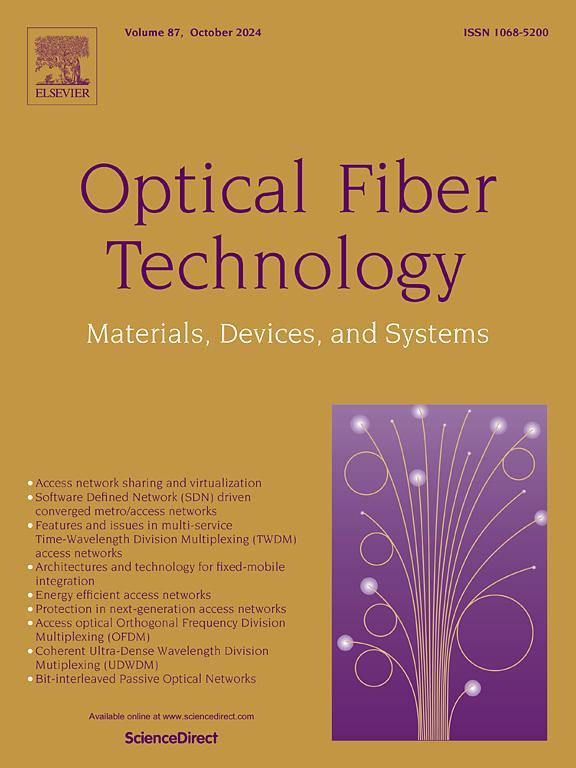Tunable random laser with a cavity based on an erbium-doped germanophosphosilicate artificial Rayleigh fiber
IF 2.7
3区 计算机科学
Q2 ENGINEERING, ELECTRICAL & ELECTRONIC
引用次数: 0
Abstract
This study is devoted to the construction and investigation of a tunable random laser with a cavity based on weak fiber Bragg gratings (the so-called artificial Rayleigh fibers) inscribed in a 3-m-long active fiber. An array of weak fiber Bragg gratings (wFBGs) is inscribed using an ultraviolet (UV) excimer laser operating in pulsed mode and a chirped phase mask during the optical fiber drawing process. The inscription of a wFBG array by a UV laser is performed using a specially designed photosensitive germanophosphosilicate preform doped with erbium ions. It is found that, in a semi-open cavity configuration, the narrow-band generation peak can be tuned within the wavelength range of 1546.5–1547.5 nm by stretching the 90 %-reflective FBGs. The resulting random lasing is characterized by a maximum efficiency of 10 % at an output power of 1 mW under backward pumping at a wavelength of 976 nm. It is established that the tunable random laser operates in continuous-wave mode with a linewidth of ∼470 Hz.
基于掺铒锗磷硅酸盐人造瑞利光纤腔的可调谐随机激光器
本研究致力于在3米长的有源光纤中嵌入弱光纤布拉格光栅(即所谓的人造瑞利光纤)的空腔的可调谐随机激光器的构建和研究。在光纤拉丝过程中,采用脉冲模式的紫外准分子激光器和啁啾相位掩模刻蚀弱光纤布拉格光栅阵列。采用特殊设计的掺杂铒离子的光敏锗磷硅酸盐预制体,实现了紫外激光刻蚀wFBG阵列。研究发现,在半开腔结构下,通过拉伸90%反射fbg,可以在1546.5 ~ 1547.5 nm的波长范围内调谐窄带产生峰。在976 nm波长的反向泵浦下,当输出功率为1 mW时,所得到的随机激光的最大效率为10%。结果表明,该可调谐随机激光器工作在线宽为~ 470 Hz的连续波模式下。
本文章由计算机程序翻译,如有差异,请以英文原文为准。
求助全文
约1分钟内获得全文
求助全文
来源期刊

Optical Fiber Technology
工程技术-电信学
CiteScore
4.80
自引率
11.10%
发文量
327
审稿时长
63 days
期刊介绍:
Innovations in optical fiber technology are revolutionizing world communications. Newly developed fiber amplifiers allow for direct transmission of high-speed signals over transcontinental distances without the need for electronic regeneration. Optical fibers find new applications in data processing. The impact of fiber materials, devices, and systems on communications in the coming decades will create an abundance of primary literature and the need for up-to-date reviews.
Optical Fiber Technology: Materials, Devices, and Systems is a new cutting-edge journal designed to fill a need in this rapidly evolving field for speedy publication of regular length papers. Both theoretical and experimental papers on fiber materials, devices, and system performance evaluation and measurements are eligible, with emphasis on practical applications.
 求助内容:
求助内容: 应助结果提醒方式:
应助结果提醒方式:


